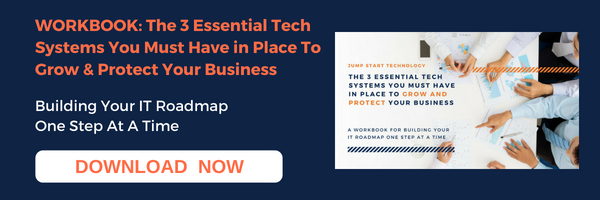As a business owner, have you experienced frustration because it seems that there is almost always a huge disconnect between the strategic level of the business and the technology layer of the  business?
business?
It’s understandable. You’re an executive; you must maintain a high-level view of the business in order to keep it operating smoothly.
Many companies often have their IT team reporting to the finance department, who makes cost-based decisions instead of value-based decisions. That’s understandable too – a CFO is responsible for keeping the business in the black.
Unfortunately, a lot of IT professionals aren’t adept at describing the value of their requests in business terms. This leads to a strong disconnect between the business strategy and the technology to support it. To make things even more difficult, if you don’t have a trusted IT partner, (either in-house or outside support) you might not be having this conversation at all.
As a result, taking advantage of new technology and getting the most from your existing IT investments can be a real challenge. In fact, CIO’s across the board identify lack of technology expertise and expansion as their number one barrier to success.
But more importantly…if you have anything in common with the more than 2500 business leaders surveyed by Gartner for the 2019 Gartner CIO Agenda Report, a few of your key priorities for 2018 include:
- Expansion of digital platforms for businesses and organizations of all sizes;
- Development of technical infrastructures to support the expansion of the digital “ecosystem”, through cloud and mobility applications, voice and data communications networks, and more.
- Building and utilizing a strong bench of IT talent to support and expand on the above priorities and invest in new technologies.
So how do you get IT and business talking together for the betterment of the organization as a whole? By going through the process of building an IT roadmap.
An IT roadmap is designed to help you align your IT projects with your strategic priorities, plan for the long term, and define your needs and priorities before making an investment. It is a process that delivers a long-term strategy to change your organization’s IT infrastructure and applications, based on what you need for your business today, and tomorrow.
Whether you’re new to the process or a seasoned IT manager, knowing just where to start when you plan a strategic IT roadmap can be difficult.
Here are the steps we recommend to get you started:
First, outline your business goals and high-priority, strategic objectives. The primary function of your IT strategy is to support your organizational or business needs, so start by outlining your business needs, goals and objectives. If you don’t already have an outlined business strategy in place, you can clarify your mission and needs by considering your sales targets, expansion plans and any other ongoing “action” plans you may have in the pipeline.
- What are your strategic priorities? What is the financial and operational impact you hope to generate?
- What tools and information can help your team become more insightful, proactive and responsive?
- How can you deliver a better experience or create additional value for your customers? In what ways can you make it easier to do business with your company?
Don’t skip this step; it’s importance cannot be overstated. Remember, the most successful organizations align their IT strategy with their business strategy.
Next, define the scope, personnel and schedule to make your plan happen. Remember, a list of goals is not a strategy. It’s important that everyone is clear about the purpose of your IT planning, who is responsible for delivering it and to whom it applies.
Your IT strategy shouldn’t (and can’t) solve all your problems at once, so even if your strategy is company-wide you need to articulate how it affects different business units and functions. Meet with key people within your organization who will be able to tell you how they are using technology resources, what they are lacking and how IT can support them. It’s also important to build a schedule-or “lifespan”-into the strategy, giving you an opportunity to review and refine the plan regularly and make changes as needed.
Review your existing IT systems and tactics. When you plan an IT strategy it’s important to remember that you’re not starting from scratch. Reviewing your existing IT systems and tactics will help you define problems, see what’s working and where resources can best be saved by making use of what is already available. As you start thinking about your IT, ask yourself:
- How is your team using technology?
- What tools, software or systems do they use?
Your answers should be in the information you’ve collected from various teams and units within your business.
What’s working? What isn’t?
Think critically about how IT is being used and analyze which tools, software and systems are providing the most value. This step will enable you to plan an IT strategy based on resources you already have. For example:
- Review your business processes and highlight inefficiencies
- Identify technology gaps or areas where your existing systems fall short
- Identify the functional capabilities needed to effectively support or improve your processes
- Prepare an itemized, prioritized checklist of what steps need to be taken.
Now it’s time to create a roadmap for your technology systems and resource allocation. This might seem like the most difficult step, but if you’ve been following the process, this should be relatively simple.
- Start by defining an overview of your technology systems (the software applications, hardware and other IT tools you will be using).
- Then consider any departmental-specific technology needs within your organization, like financial or HR software.
- Finally, think about how the parts in your tech systems fit together, and what processes are needed to integrate them within the organization.
Next, measure the cost. Major technology initiatives can be expensive and capital intensive. The investment required can vary significantly depending on the size of your company, your industry and the complexity of your requirements. Make sure you research pricing and include a realistic cost estimate for each project in your roadmap. Also take account of additional or ongoing costs such as new infrastructure costs, subscription fees, annual maintenance and support fees.
Last but not least, define your metrics. Since your IT strategy is supporting your business needs, you need to make sure that it is functional and cost effective. This is why it’s important to identify some key metrics and KPIs that you can use to benchmark and analyze the performance of your IT strategy over time. These might include:
- number of help desk calls,
- operational indicators (like ISP capacity) and budget,
- customer and end-user measurements.
Remember, your IT Roadmap is a document that evolves over time. As your business grows, your priorities may shift and new opportunities or challenges may present themselves. Your IT strategy may also change as a result. Preparing your technology roadmap is not a one-time event. Rather, it is a living document that should be regularly updated, reconsidered and revised.
When done right, an IT strategy can be a powerful tool to drive growth and efficiency in your business, supporting your goals and your staff directly. Don’t worry about getting your technology roadmap perfect the first time around. Just get it started and keep working on it so that you move closer to achieving your goals.




